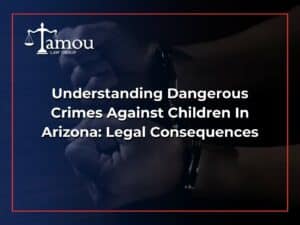Understanding the Process and Impact of a Restraining Order in Arizona
If you’re feeling threatened, harassed, or otherwise in danger, one of the legal protections available to you is a restraining order. Today, at Tamou Law Group PLLC, we will be discussing the intricacies of obtaining a restraining order in Arizona, shedding light on its impact, and the statutes that govern it under Arizona law. It is our aim to provide you with the knowledge you need to navigate this potentially complex and emotional process.
First, it’s important to understand what a restraining order is. Known officially in Arizona as an Order of Protection or an Injunction Against Harassment, this legal order forbids a person from contacting or approaching another person. It’s often used in cases involving domestic violence, stalking, or harassment.
According to Arizona Revised Statute §13-3602, an Order of Protection can be issued against a person in a current or former romantic or sexual relationship, a relative, or a person living in the same household. Alternatively, an Injunction Against Harassment can be issued when there is no familial or romantic relationship between the two parties.
The Process of Obtaining a Restraining Order
The process of obtaining a restraining order in Arizona involves several steps.
- Filing a Petition: The person seeking protection, known as the petitioner, must file a petition at a court, providing detailed information about the events that led to the request.
- Judicial Review: A judge will review the petition. If the judge believes the petitioner is in immediate danger, they will issue an emergency order that lasts until the court hearing.
- Court Hearing: Both parties will attend a court hearing where the judge will decide whether to grant a permanent restraining order. The respondent (the person against whom the order is filed) has a chance to contest the order during this hearing.
- Service of the Order: If the restraining order is granted, it’s not enforceable until it has been served to the respondent. In Arizona, this is typically done by law enforcement officers.
The Impact of a Restraining Order
A restraining order can have a profound effect on both parties. For the petitioner, it provides a legal shield, potentially stopping threatening behavior and creating a safer environment. For the respondent, it can significantly restrict their freedoms, as they’re prohibited from making contact with the petitioner and possibly their children, and may be required to move out of a shared residence.
Violation of a restraining order is a serious offense. As per Arizona Revised Statute §13-2810, a respondent who knowingly violates an order of protection can be charged with a class 1 misdemeanor, which carries potential penalties of up to six months in jail and a $2,500 fine.
In Conclusion
While obtaining a restraining order in Arizona can be a challenging process, it can offer a critical layer of protection for those dealing with threats or harassment. It is crucial to understand the process, the potential impacts, and to navigate these proceedings with knowledgeable legal representation.
At Tamou Law Group PLLC, we believe that everyone has a right to safety, and we’re committed to helping you understand and navigate your legal options. If you need assistance or have any questions related to restraining orders, do not hesitate to contact us at 623-321-4699. We’re here to help.
Remember, no one should live in fear. Know your rights, understand the law, and always seek legal counsel when faced with situations involving your personal safety.
This blog is intended to provide general information and is not a substitute for legal advice. If you are in immediate danger, call 911.

Tamou Law Group
Scottsdale Office
9375 E Shea Blvd #100
Scottsdale, AZ 85260
Phone: 623-321-4699


![The Top 3 Probation Violation Lawyers in Phoenix, AZ [2025]](https://tamoulawgroup.com/wp-content/uploads/2025/11/phoenix-probation-violation-lawyer-300x300.png)
![How to Beat a DUI Charge in Phoenix, AZ [2025]](https://tamoulawgroup.com/wp-content/uploads/2025/08/best-phoenix-dui-lawyers-300x300.png)